News . . .
November 9, 2007 - B.C. tourism operators ask government . . .
http://www.savebcsalmon.ca/index.html and signatories via:
http://www.savebcsalmon.ca/signatories.html
B.C. tourism operators ask government to curb salmon farming
Ben DiPietro
IntraFish
Published - November 09. 2007
Saying they moved aside to allow the British Columbia salmon farming industry a chance, a group of mostly tourism-related business owners has paid for a national newspaper ad calling on the Canadian government to move some of the farms away from the largest wild salmon migration routes.
The group, savebcsalmon.ca, ran a full-page ad in Friday's national edition of The Globe & Mail newspaper, saying the environmental toll the farms are taking on the region are too great to ignore.
"We are people that depend on BC wild salmon. We moved aside to allow corporate fish farms into the waters we share, but we write you now because fish farming is harming wild salmon, our communities and our livelihoods. Too many farms are in the wrong places," the ad says.
It goes on to say when four-year-old Fraser River sockeye went to sea in 2005, they were heavily infected with sea lice around the Campbell River fish farms.
"So few of these salmon returned that the entire south coast commercial fishery has closed," the ad says. "Today, young wild B.C. salmon all the way from the Fraser River to Cape Caution are exposed to fish farms and being infected with sea lice. This is high-risk management, or in our view, mismanagement."
Wild salmon support commercial and tidal recreational fishing and, when combined with wilderness tourism, means wild salmon annually lure over CAD $1.6 billion ($1.7 billion/€1.16 billion) to B.C., compared to the $600 million ($637 million/€434 million) earned by farming fish.
"Why isn’t your government listening to the businesses that depend on wild salmon?" the ad asks.
The ad asks people to sign a petition calling on B.C. Premier Gordon Campbell, B.C. Fisheries Minister Pat Bell, and federal fisheries minister Loyola Hearn to take action to protect wild salmon.
"Ministers Bell and Hearn, you are in the hot seat. We can have wild salmon and farm fish, but unless you fix what is broken, you will extinguish B.C.’s greatest renewable resource. Threatened is one of the earth’s largest migrations, which passes through the waters of the city of Vancouver, host of the 2010 Olympics," the ad says.
"Salmon are the life-blood of British Columbia. You can give Broughton and Fraser River salmon immediate sea lice relief. Remove fish farms from Broughton and Discovery Island wild salmon migration routes and halt their spread to the north coast. You must act now to save our salmon."
www.intrafish.com
Don Staniford
European Representative
Pure Salmon Campaign
Email: dstaniford@puresalmon.org
Tel: +1 202 251 3997
Website: www.puresalmon.org
September 2007 - Crusader in Financial Straits
In a summer of oil spills, disappointing salmon returns and slack fishing lines, there is some good news for salmon on the West Coast. The Glendale River, a major pink salmon stream on the B.C. mainland, is in tiptop shape thanks to the determination of Blake Covernton of Pro Plan Services in Nelson, and his crack team of spawning channel gravel cleaners, who worked closely with dedicated fisheries guardians from local First Nations to restore the Glendale spawning channel. The only downside to the story is that Covernton is now left holding most of the tab - about $100,000 - and is looking for help.
"The Glendale was on the verge of serious trouble," says Covernton, who was previously a commercial fisherman and is now a project scheduler with big oil clients in Alberta's booming tar sands. "I knew the DFO wouldn't be able to deal with it before the salmon returned this August and by next year it might be too late. I knew I could do something about it, so I put the team together and we went to work".
The Glendale River has of late been the only significant producer of pink salmon throughout the Broughton Archipelago and Knight Inlet area, situated between N.E. Vancouver Island and the BC mainland. In 1988, Fisheries and Oceans Canada built a spawning channel to help augment salmon runs near where the river runs into Knight Inlet. Wild salmon coming from the Glendale River provide a major food source for grizzly bears that frequent the area, drawing thousands of tourists each year. With local bear viewing operations and local First Nations concerned about the state of the spawning channel, it seemed crucial to conduct a survey of the Glendale Channel and to act on the expected results. Victor Ewert, a former DFO employee and now a fisheries consultant with Redfish Services (Hedley) was hired to do an assessment in June.
"[Spawning channels] cannot remain productive without a certain degree of maintenance and management," Ewert says. The spawning gravel was clogged with brown organic matter, which chokes salmon eggs. During the assessment, Ewert says he observed massive amounts of dead eggs in the muck covered gravel.
"Merely walking on the gravel created large plumes of brown organic matter," he wrote in his report. "Based on my assessment of the current gravel bed conditions in the Glendale Channel, I highly recommend that a cleaning operation take place."
That was on June 27th, and pink salmon were going to start entering the river in mid-August. The DFO was unable to take any immediate action, but Covernton did. He pulled together a crew comprised of Vic Ewert at Redfish Services (Hedley), Pacific Erosion Control Systems Ltd. (Sointula) as the general contractor and Alfred Coon and James Speck Jr. from DMT Fisheries Society (Alert Bay).
"I've had a vision now for over a decade that all people who rely on wild salmon will work together to ensure healthy wild salmon stocks in BC," states Covernton (see www.wildbcsalmon.ca). With permission granted in record time from local DFO officials, the Da'naxda'xw First Nation and BC government, the clean up operation was mobilized immediately to get to work during a narrow window of opportunity dictated by tides and the arrival of adult spawners.
With controlled water flows, the channel gravel was cleaned and mixed prior to the arrival of spawning salmon. "This project will help ensure the survival of not only the Glendale River pink salmon run, but could also serve as the seed stock for other Mainland pink runs that are now severely depressed," Coverton says. The project was completed ahead of schedule by July 15 and came in slightly under budget.
The Glendale River is in the Da'naxda'xw First Nation's traditional territory. Their resource manager is Fred Glendale, who toured the project site with Tim McGrady, Operations Manager of Knight Inlet Lodge.
"Initially we were very concerned about this gang rushing in here without much communication," comments Fred, "but we very quickly realized the intent of this Covernton fellow. I went up to the site and witnessed the importance and the quality of the work being performed on a project that is well overdue. Our people give this team praise and we have asked them to discuss further salmon restoration work at a meeting this fall with our Chief and Council."
In total, the clean up operation cost $163,927. With virtually no time in which to raise funds, Covernton paid most of the invoices out of his own pocket. Responding quickly to Blake's requests for financial assistance were the BC Wilderness Tourism Association, (an organization comprised of tourism operators) and the BC government's Pacific Salmon Forum, who contributed $11,500 and $50,000, respectively. Covernton covered the shortfall of $102,427 himself, with a combination of his own cash and loans from friends.
Covernton remains passionate about the project. "Essential efforts are now aimed at fundraising as I can't afford to carry this financial burden myself, and I am very hopeful that other people will share my concern and contribute to these actions taken to reverse the reduction in wild salmon populations."
When will we see the results of Covernton's selfless act? It won't be until next spring. "No matter what happens with the financing, I am confident I contributed to the survival of pink salmon on the BC coast." And he adds, "that means a lot to me. I will never regret the decisions I made this summer. If we are going to make a difference we have to get on with the work, perhaps thinking a bit more like salmon than like people! "
For Covernton, the future is all about bringing industries, governments and concerned groups together to ensure the health of a precious resource.... Wild Salmon!
If you wish to contribute please send to:
Watershed Watch Salmon Society
1037 Madore Ave.
Coquitlam, BC V3K 3B7
Tax receipts are issued for all donations. Charitable registration # : 86948 9476 RR0001
Please Mark Your Donations for the Glendale Channel Project
Lori McQuid
WWSS Administrative Coordinator
604-936-9474
For more information contact:
Blake Coverton: 250-354-9054 email: proplan@shaw.ca
Brian Gunn of the Wilderness Tourism Association of BC (250) 286-4080
July 22, 2007 - Glendale Channel cleaning report
Report
Prepared by:
Victor Ewert
Redfish Services
July 22, 2007
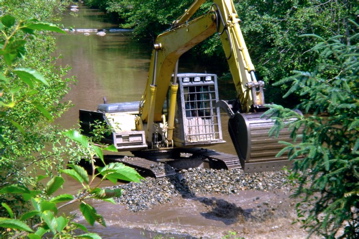
Cleaning
Procedure & Methodology
After approval was given from Fisheries &
Oceans Canada, the Province of BC and the First
Nations and all of the concerns of other interested
parties as to procedure and methodology were
satisfied, the equipment to clean and remix the
gravel beds in the channel was mobilized from
Mitchell Bay to Glendale Cove on July 04, 2007.
Site preparation began immediately on arrival, July
5. Scouting out suitable locations for dry land
pumping was initiated. Fish traps were placed in
five separate locations, generally at the holding
pool areas. All equipment was mobilized to the work
site.
Since cobble removal from the beds would not be
possible due to poor visibility once cleaning
started, two passes down the full length of each
channel leg was done. (Photo 1)
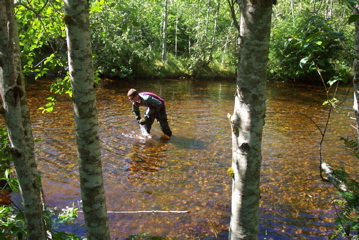
Photo 1 – Removing
large rocks from beds
All large rocks were placed on the berm walls.
Environmentally friendly, biodegradable oil was
used as the hydraulic product. At the same time,
all deadfall consisting of rotten alder trees lying
on the beds was removed.
Another, two-man crew began the limbing of the
lower riparian growth to allow the excavator
operator to see well enough to clean up to the bed
edges. All limbs were placed on the berms. (Photo
2)
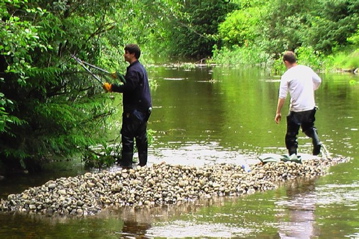
Photo 2 – Limbing lower
branches
While the crews were removing the cobble and
limbing lower branches, access to the first pumping
location, approximately two-thirds of the way down
the last leg was done.
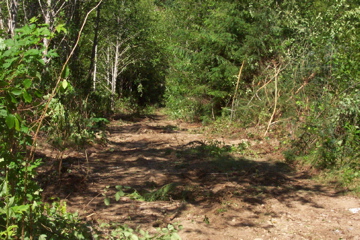
Photo 3 – Access road
Nearly 20 years of alder growth needed to be
removed. Access points were punched in - one at the
bottom of Leg 3, the other at the bottom of Leg 6.
(Photos 3 and 4)
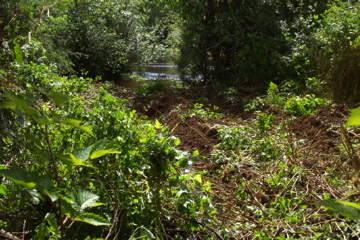
Photo 4 – Entry – exit
to the channel leg
All of the pumping gear was placed at the first
pumping location. (Fig. 1)
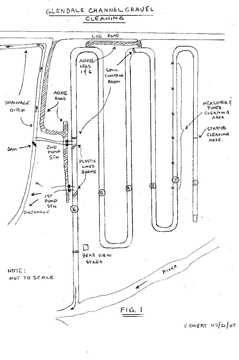
With flows reduced, stop logs with a plastic lining
were placed at the channel outlet to retain any
turbid water. (Photo 5)
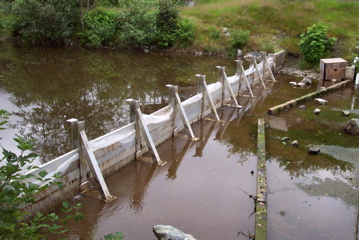
Photo 5 – Outlet
plastic-lined dam
A retaining, plastic-lined gravel dam was made,
pump intake hoses placed and the containment area
behind the dam was pumped out. Fish salvage was
conducted in this area. (Photos 6 and 7)
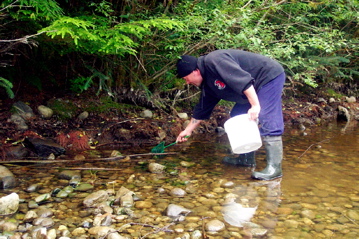
Photo 6 – Fish Salvage
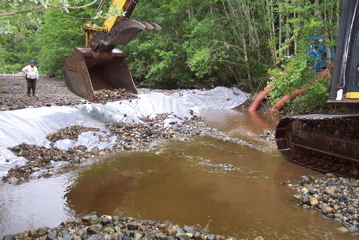
Photo 7 – Gravel
plastic lined dam at first pumping station
Before cleaning was started, the excavator entered
the bottom of the channel and scalped off high
points of the gravel from the bottom to the top to
permit a faster laminar flow and improve effluent
transport. Gravel depth varied from near zero to
approximately 90 cm. A reduced flow exposed high
points and facilitated the rough leveling.
Two spill containment booms were placed in the
channel legs in the event of a hydraulic oil spill.
(Photo 8)
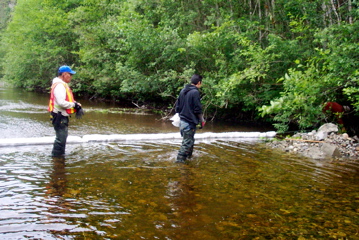
Photo 8 – Spill
containment boom
During cleaning, flows were kept at the background
level before arrival and were estimated to be less
than 40 cfs (.85cu/m/s) since the pumps were rated
at this level and were able to keep up with the
flows when screens were clean.
In order to determine the desired rate of cleaning,
taking into account the time restriction, a 165 m.
section, taped every 33 m. was measured out. The
pace of cleaning was 33 m. per hour.
The scoop and recast cleaning method, as described
in the Gravel Assessment Report, was used. (Photo
9) To briefly recap: Using the water and current to
flush out the silt and organic matter, including
large numbers of dead eggs, the excavator scooped
up and recast the gravel over a broad area until
the gravel appeared clean and the bulk of the brown
organic matter was flushed out.
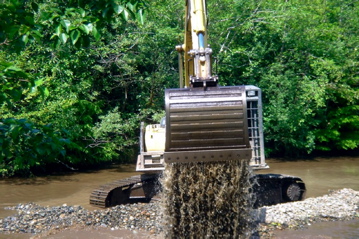
Photo 9 – Scoop and
recast cleaning method
This process was repeated three or four times in
each area before the excavator was moved a short
distance downstream. As cleaning continued, a
progressively deeper layer of organic goop
accumulated behind the machine. In order to move
this material, it was necessary for the excavator
to repeatedly rotate and plunge the bucket up and
down vigorously, forcing this sludge downstream.
During this necessary process, many small branches,
extending well over the channel beds were broken
off. These branches found there way to the pump
intake screens and plugged them up, necessitating
several cleanings per day. There was also a
continual concern of the sharp ends of the broken
limbs rupturing the hydraulic line hoses. (Photos
10 and 11)
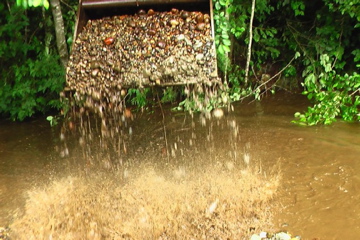
Photo 10 – Cleaning
close to the berms
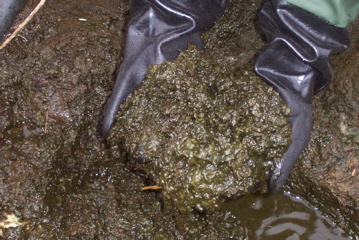
Photo 11 – Accumulated
organic goop
It was necessary to mark out and flag all the
holding pools in the channel legs. (Photo 12) Once
cleaning started, it was important to find them to
prevent the excavator from backing into one. The
‘planned’ drawings in the authors’ possession did
not reflect the ‘as-built’ locations.
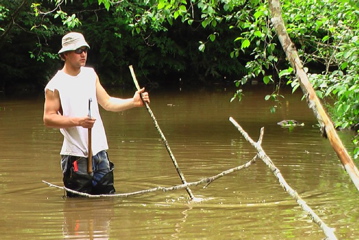
Photo 12 - Marking the
deep pools
The First Nations personnel, Alfred Coon and James
Speck Jr., took daily sediment wedge readings as
well as flagged and brushed out trails along both
the left bank of the river as well as along the
drainage ditch complex after the pumps were
relocated. (Fig. 2)
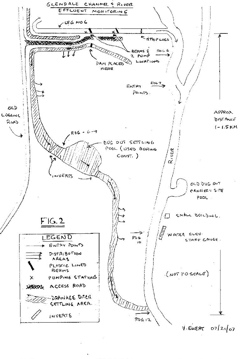
Fig. 2
After one and a half days of cleaning and pumping
at the first location, a small amount of organic
laden water, estimated to be .5 cfs (.01 cu/m/s),
was observed entering the river at two locations
nearest to the channel outflow area. (Fig. 2) No
other entry points were discovered over a
downstream distance estimated to be 1.5 km.
Although there was no concern of silt entering the
river, the goal was to deny as much effluent into
the watercourse as possible. It was felt that over
time, if discharge continued at the first pump
location, the ground would become saturated due to
the high water table present, and more and more
organic laden water would then find its way outside
of the discharge area.
Cleaning was stopped and an alternate area was
searched for. An extensive network of drainage
ditches and settling areas was discovered. (Photos
13 and 14)
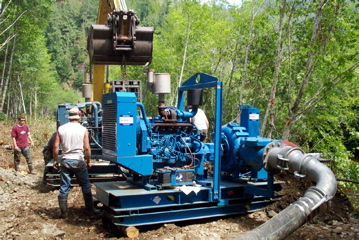
Photo 13 – Second
pumping station
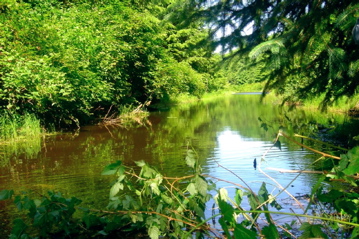
Photo 14 – Drainage
ditch
To encourage flows in the desired direction, away
from the river, a dam was put in a ditch adjacent
to the cleared roadway to Station No. 1. (Fig. 2)
This second location, Photo 15, approximately
one-half way down Leg 6, (Fig. 1) proved superior
with the vast majority of flow going down the
ditches and into the settling areas. It overflowed
at various points onto the forest floor. A total
reentry amount of approximately 1 cfs, (.021
cu/m/s), or less than 2.5 % of the volume pumped
was noted in four locations over the monitored
area. A metered stick was used to ensure no backup
of levels occurred. Sediment wedge readings are
covered in the summary section.
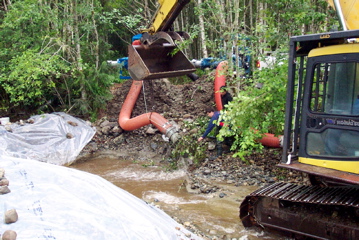
Photo 15 -
Plastic-lined dam and second pumping station –
Cleaning the intake screens
The second station also had a plastic-lined dam
below the pumps and this gave two holding areas for
dirty water. (Photo 15) It was observed that since
only the top sides of the dams were
plastic-covered, once pumping started again (one
pump shut down at a time) after the cleaning of the
screens, the dirty water flowed back through the
gravel dams and was pumped out. This ensured that
while servicing the screens, this accumulated dirty
water could effectively be removed.
As cleaning progressed, an odor similar to sulphur
dioxide and decomposed eggs, permeated the air.
This attracted a number of grizzlies who appeared
to be undisturbed by the noisy pumping and cleaning
activity. Daily sightings were the norm. Vigilance,
noise, personal bear spray and two-man crews were
employed as safety measures.
The entry points (Fig. 1) allowed for the entry and
exit of the excavator for daily servicing and
fuelling. No fuelling was done in the channel.
Cleaned areas were not traveled on by the machine
once cleaned. Travel in and out was restricted to
the nearest downstream entry point as cleaning
progressed.
The various holding pools in the channel legs were
not only dangerous for the operator, but acted as a
large sump or basin which collected the heavy
organic material up to .5 meters deep. As much of
this material as possible was dislodged by plunging
the bucket up and down. It was impossible to remove
all of it since there was no water flow to assist
dispersal. This subject is also covered in the
Recommendations section.
Cleaning operations were stopped approximately one
hour before pumping stopped. This allowed for
servicing the machine as well as all the dirty
water to reach the pumps and be discharged. In the
morning, while the dirty water had not yet reached
the pumps, the two holding areas below the dams,
were pumped out. Once several legs were cleaned,
all broken branches, etc., were removed, as well as
any cobble that showed up from the remixing
process. This process was repeated with the result
that all of the legs were covered three times in
the large rock removal exercise.
Fabric liner was encountered in two locations. It
was deteriorated and all of the pieces encountered
were dug out and removed using hand shovels. At the
same time, any excessive mounds of gravel resulting
from the cleaning were leveled out. The goal was
not to create a table top, flat gravel bed, just
remove the highest points to increase laminar flow
and reduce obstacles during freezing periods. An
uneven surface is superior for spawners since
undulations on the surface assist in intra-gravel
water flows, and provide oxygen laden water during
the development stages.
Summary & Concluding Remarks
Fish traps placed in the channel prior to cleaning,
as well as during the night for several days after
cleaning started resulted in a catch of the
following: 23 coho; 62 sculpin and 20 bullhead. All
of the fish were either relocated to the river
(side channel) or taken (some coho) by Knight Inlet
Lodge staff for a cap trough coho display. After
dewatering the area below the first pumping station
dam, salvage efforts resulted in the recovery and
relocation of 28 sculpin and 2 coho.
It was interesting to note that the distinct odor
emanating from the cleaning process had more of a
dead egg smell in the first three legs and this
reflects the initial assessment that most eggs were
found in the upper section of the channel. This is
what undoubtedly attracted the bears. After Leg 3,
the odor was not as pervasive and changed to a
decaying organic matter smell.
With the exception of Leg 2, after the
cleaning/remixing was done, the gravel composition
had the appearance and texture of a well-mixed,
clean, fluffy gravel bed. Leg 2 appeared visually
to lack the same amount of smaller particles as the
other legs. The volume of gravel expanded visibly
due to the loose nature of the medium. (Photos 16
and 17)
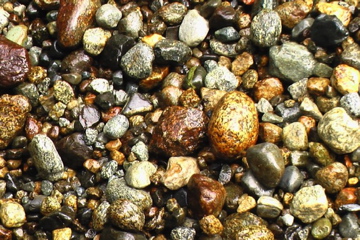
Photo 16 – Cleaned gravel with a good mix
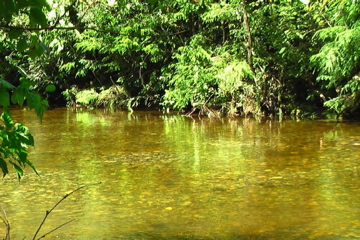
Photo 17 – Cleaned
gravel beds
Sediment wedge readings, using the Triton Sediment
Wedge showed, as expected, that the lowest -0-
(dirtiest) readings were close to the cleaning
process with readings progressively higher over
distance. (Photos 18 and 19)
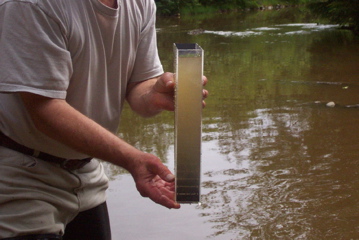
Photo 18 – Sediment
wedge readings
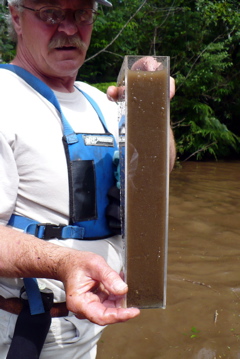
Photo 19 – Sediment
wedge reading
Readings at the pumping locations were usually from
5 to 7 except when the cleaning came closer to the
intake hoses. Then readings once again were 0 or 1.
It was surprising to note that readings at the four
river entry points (Fig. 2) ranged from 6 to 12,
despite some locations being at least 1 km. away
and having already passed through some large
settling areas. This illustrates the extreme
colloidal nature of the organic or volatile residue
material. Obviously, any silt or non-filterable
residue settled out quickly and never entered any
watercourse.
Test holes dug after cleaning showed the gravel to
be very loose, well mixed and at least 80 % cleaner
then when started. Due to the time constraints and
the budget allocated, a 100 % cleaning was not
possible. With beds as filled with foreign material
as this one was, another cleaning in a subsequent
year is generally done.
The holding pools or ‘settling pools’ remain
problematic. It is unfortunate that a considerable
amount of organic material will be redistributed
once the spawners arrive and this will
recontaminate the cleaned gravel beds.
All disturbed sites were seeded, all the dams that
were placed, the ditches that were obstructed, the
disturbed entry points, etc., were all returned to
an as-original condition as was possible. All
stakes, flagging and garbage was removed. The cabin
on site that was used to keep project equipment was
cleaned and preexisting gear inside was organized.
All the concerns expressed by all of the interested
parties were met. The project was completed on
schedule, by July 17, 2007, as originally forecast.
Although a comprehensive list of recommendations
was not asked for and was not part of the
cleaning/remixing exercise, it is recognized that a
greater degree of operational monitoring and some
infrastructure work is necessary to ensure
quantifiable data and to maintain the physical
integrity of the facility. Now that the gravel has
been rejuvenated, there exists an opportunity to
employ some basic protocols that are more in
keeping to those of the channels in the Fraser
watershed and those on Vancouver Island. It should
be evident that an engineered facility requires
maintenance, especially where gravel is concerned.
Without a program to maintain the parameters that a
facility was built to, it is inevitable that within
a few short years, conditions will deteriorate, and
the egg to fry survival levels will plunge. An
opportunity currently exits with First Nations
interest and the desire and proximity of the Knight
Inlet Lodge, to become more involved.
Acknowledgements
The author wished to thank F&O Canada, the
Province of BC, the First Nations people, Knight
Inlet Lodge staff, the numerous donors who helped
with this project and lastly, but no less
important, all of the personnel who
enthusiastically and energetically worked to make
this a successful venture.
Recommendations:
Basic Operations – Adult Period –
Density loading, adult timing in loading, sex
ratio, fecundity, as well as prespawn mortality
(PSM) numbers and egg retention should all be
addressed. This sampling and monitoring regime
would ensure that proper loading for background
conditions (water temp., and dissolved oxygen – DO)
was done; ensure that run timing was not altered;
ensure a balance between female and males rather
than early male dominant concentration; and would
provide confident parameters to give reliable egg
deposition numbers. Annual sampling of
weight/length would track oceanic conditions, etc.,
over time. The installation of an electronic fish
counter would be invaluable in order to achieve
optimum density loading.
Basic Operations – Fry Emergence –
Early fyke net installation based on accumulated
thermal units (ATU) and timely enumeration
equipment (dewatering screens, collection troughs
and proportional sampler) needs to be set up and
maintained throughout the emigration period. It is
suggested that a more accurate proportional sampler
be used and this would provide more accurate egg to
fry survival (e/f) numbers and would also allow for
easier installation and operation. Sub-sample
weights and lengths throughout each migration
should be done.
Basic Operations – Data Loggers –
Keeping track of ATU’s is a simple, effective tool
to determine the development stages, especially the
hatch and emergence stages. This tool allows for
accurately predicting emigration and thus avoids
missing any early emergence. Ideally, several
should be employed in at least the top and bottom
locations.
Basic Operations – Flow Regime –A
water management regime that provides adequate
flows (but not more) to reflect adult needs, hatch
stage, fry emergence and ‘off-season’ or background
flows while still ensuring reliable water storage
in Tom Brown Lake is suggested. Flows need to be
calibrated to staff gauge settings.
A channel can not be all things to every species.
At the Glendale channel a specific species was
targeted in order to enhance a specific area. A
dewatering period as is common in many channels,
allows for a fallow period where the gravel is
partially sterilized by the sun, algal growth is
severely reduced, and water storage is gained. A
review of priorities is recommended.
Infrastructure & Maintenance:
Gravel Bed/Mix & Cleaning – It
should be noted that due to the size (a generic
sockeye channel mix) and the angular nature of the
gravel medium, it is more important than would
otherwise be the case, to keep the gravel clean and
mixed in order to achieve the maximum e/f
production. The two most critical components for
vigorous and healthy fry production are a high
quality water source and a high quality gravel
medium. It is recommended that the degree of
organics and stratification be noted annually and
that the gravel be cleaned as required. Most
channels are cleaned from every year to every
fourth year.
Pool Removal – Holding pools were
ill-conceived ideas that have more disadvantages
than benefits. This is now understood and these
pools have been filled in and the area used to
increase spawning area. The Horsefly Channel is one
example. It is recommended that this be done at
Glendale Channel, especially since a stored gravel
source is available on site. In the mean time, when
another cleaning takes place, the use of small
trash pumps would remove some of the deleterious
matter. This process may not be possible at all six
pool locations.
Valve – A complete range of
opening and closing should be conducted at least
once per year. If it is not possible to do this, as
is the case at Glendale, consideration should be
given for a valve replacement. At present, the
actuator portion is not operating correctly. Plans
are currently underway for its replacement.
Outlet Guide Posts – Most of the
guide posts are no longer secure. These need to be
replaced/repaired in order to be able to use the
stop logs effectively for both adult and fry work.
Staff Gauge – The staff gauge at
the top end presently reads the water elevation in
the top leg and will change when the gravel profile
changes and when the biomass of the spawners enter
this leg. Stop logs (now missing) need to be placed
in the outflow chamber. Once a range of flow
volumes have been metered, volumes can be compared
to the staff gauge readings. The system now in use
is at best a guess.
Alder Tree Removal – It is
recommended that the alder trees be progressively
thinned over a three year period and if necessary,
thin the coniferous growth as well, or plant some
where needed. Already, branches extend half way
across the beds in places. Keeping in mind that
alders have a lifespan of 35 or 40 years and that
as the trees get larger, more leaf litter will
occur; it is highly recommended that some action be
taken as soon as possible. Left alone, an identical
accumulation of decomposing leaf liter will occur
as has been the case, with the additional problem
of the alders falling down into the channel beds.
From an operational and production perspective,
this is the single biggest cause of the
deterioration of the gravel in the Glendale
Channel.
Victor Ewert
Redfish Services
June 28, 2007 - Glendale Channel gravel assessment
The scope of the assessment conducted on June 27, 2007 was confined to issues of gravel
quality and the factors that could adversely affect intra gravel flow and the egg to fry survival (e/f) and subsequent efficiency and production of the channel. Operational concern such as density loading, timing of adult loading, water level flows, sampling regimes, fry enumeration methodology, etc., are deferred but merit a review in order to achieve the optimum benefits from the channel. As well, maintenance issues are also deferred except where it relates directly to the gravel bed quality itself, or are at the point of jeopardizing the facility itself.
The first impression from both the air and the ground is that the channel is overgrown with riparian vegetative growth, mostly alders which cover approximately 50 % of the gravel beds. In some cases this growth extends half way across the 15 meter wide beds. (Photos 1 & 6)
Photo 1:
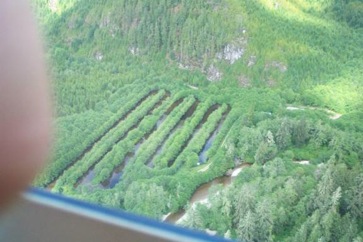
In general, the overall appearance reflects that very little maintenance has been done and no attention has been paid to the gravel beds since inception in 1988.
Methodology & Procedure
Staff from the Knight Inlet Lodge assisted in the gravel examination and reduced the flows by 50 – 60 % (H. Payne, pers. comm.) in order to better examine the gravel. It is acknowledged that the ideal scenario would be to totally dewater and then examine the walls at each excavation site to determine the degree of siltation and organics in the voids as well as the degree of particle separation. The number of dead eggs flushed out were noted as well as the degree of algal matter both in the gravel and on the surface. Additionally, bed depth variations were noted.
The holes and visual approach method was standard procedure at all the International Pacific Salmon Fisheries Commission (IPSFC) channel sites (now DFO). Initially, no field notes, just a good look at the condition. This served the IPSFC fairly well except that the expected results of a higher e/f survival did not always materialize after the gravel cleaning. It was observed by the author that the second year after cleaning the survival went up, not down as expected with dirtier gravel. It became apparent that spawners were partially remixing the gravel and that the air/water cleaner inadvertently caused gravel stratification. Visual checks confirmed this and the degree of stratification became a critical component in determining the health of the gravel beds. Subsequent e/f survival increases confirmed the importance of a well mixed gravel medium.
A minimum of two excavations, randomly chosen, using a garden variety shovel, were done in each leg. Each hole was dug down to the substrate.
The degree of aquatic vegetation and riparian growth overhanging the beds was also noted.
Findings
A large volume of gravel has been progressively moved downstream in the top leg to the bottom of this leg. This is a result of large numbers of spawners congregating at the top and moving the gravel over time. Almost the entire, leg is now lost to spawners due to the excessive water depth which is over 2 meters at the deepest point. At the end of the leg, where the gravel is usable, large amounts of coarse fines are visible. This originates from the substrate layer below the gravel beds. Also visible at this point is the presence of rip rap material, originally from the channel berm edges and is now scattered over the beds. This material was strewn over the entire bed width from the top to the bottom in the channel. Some individual pieces were in excess of 45 cm.
Approximately one third of this material was randomly scattered and the remainder was confined to about 3 meters on either side which severely impacts this area as usable gravel. Since the original design specifications allowed for less than 30,000 spawners and in recent years the loading has been in the order of 80,000 to 100,000 (C. Beggs, pers. comm.), it is probable that the sheer number of spawners have effectively destroyed the berm walls.
Some rip rap pieces were encountered in the gravel beds below the surface while doing the excavations. Much of the original cobble, or rip rap, originally present is visibly absent. At the bottom of leg No. 4, large rip rap pieces are in a rough diagonal across the entire leg. There is no apparent reason or explanation why or how this occurred.
Even before attempting to penetrate the gravel, the angular nature is visibly apparent. This material grates against other particles, tends to lock into place, and does not provide ideal voids for egg and alevin development. Angular gravel makes it more difficult for spawners to move and is not as suitable as gravel that is more like round drain rock, for example. Because of this angular nature, it is even more important that other qualities, such as cleanliness and of a good mix are present.
The existing gravel consists of the same generic mix as that in all the former IPSFC sockeye channels. A percentage of particles from .2 to 1.6 cm. (.5 to 4in.) make up this mix. As a rule of thumb, salmonids prefer gravel with an average diameter of 10 % of their body length. Based on this, the gravel composition percentage appears on the big side, especially since the sizes of the pinks are smaller than sockeye.
There is a very apparent lack of smaller material visible, especially in the top 4 legs. The gravel profiles were not able to show where this small material ended up due to flows being on. This is unfortunate. It is suspected that this material is at the very bottom of the beds. Starting in leg 4, less large material was noted on the top of the gravel and smaller particles started showing up in the mix. Stratification became less pronounced, digging with the shovel was easier, indicating looser gravel. The last leg, once again, showed more, larger material in the top portion of the gravel column.
The process of stratification occurs over time due to the particle mix (shake a can of mixed nuts and the big stuff comes to the top). Left over time, a top layer of the larger material will have numerous negative results. The poor mix will allow excessive light penetration; cause eggs to clump together at the top of the small material layer; cause difficulty for spawners in moving the gravel; increase intra gravel flow beyond optimal levels and will cause the alevins to expend energy maintaining position in the faster flow rather than in growth; and could allow hydra explosions with very negative consequences.
Massive amounts of dead eggs were flushed out while digging the holes. The author has never encountered this degree of eggs in previous gravel examinations at any site. Again, in general, large numbers of eggs were noted, especially in the top 4 legs and progressively less with only a few present in each hole at the bottom end. More eggs were observed in the last leg.
Large numbers (hundreds) of partial redds were visible on the gravel surface where it was not obscured by a layer of algal and what appeared to be dead organic matter. These partially dug redds indicates the difficulty encountered with the compacted gravel.
Merely walking on the gravel created large plumes of brown organic matter. This occurred throughout the channel, completely obscuring the gravel in only a few cm. of water.
Photo 2:
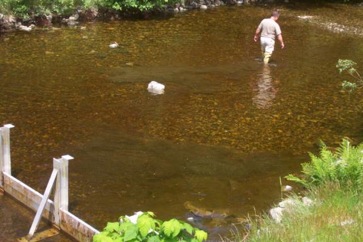
This material, which appears to be partially decomposed organic matter became progressively worse down each leg (except the last leg), in some cases covering 90 % of the gravel. (Photo 3)
Photo 3:
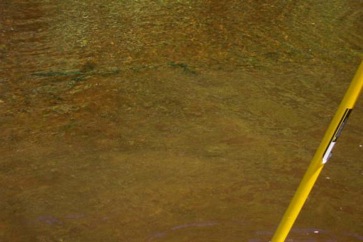
Some patches of live algal growth were seen as well, again more in the bottom half of the channel.
During each excavation, large amounts of brown, powdery material was flushed out and this was encountered from the gravel surface to the where actual silt was encountered. (Photo 4)
Photo 4:
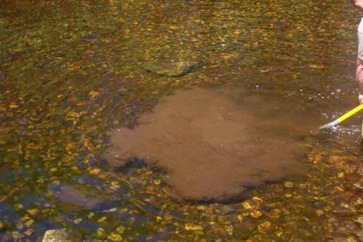
Once the actual silt was hit, the color changed from a dark brown to grey. (Photo 5 below)
Photo 5:
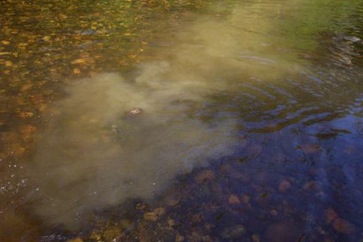
More live algae was observed starting in leg 5, where green algal growth was seen throughout.
Gravel bed depth is no longer uniform. It varies from zero in some areas to 80 cm.
As mentioned in the introduction, mostly alder branches hang over the beds on both banks. This growth, while very beneficial for shade which assists in keeping the water cool during the spawning period, especially, is an impediment when maintenance of the channel beds is necessary. The value of a healthy riparian zone along natural streambeds is ideal, but excessive vegetation along the bank of an engineered channel with a very low gradient and with no ability to regenerate gravel or self-clean during freshets, is problematic on two fronts. Leaf litter, etc., drops into the channel and becomes part of the organic mass which will consume oxygen during decomposition, especially coupled with large amounts of algal material. This situation is exacerbated even if the fall leaf loss does not coincide with the spawning period. Alder leaves are heavy and sink onto the gravel where they decompose. So, coupled with a high background organics, the total amount from all sources will reduce available dissolved oxygen (DO) in the gravel column.
Secondly, excessive vegetative cover, while highly desirable during summer months to keep temperatures acceptable will have the opposite effect during the developmental period. The ability of the sun to shine on the gravel beds is highly beneficial during cold periods since the gravel beds act as a heat sink or passive solar collector and keep water temps elevated enough to significantly reduce the formation of frazzle or anchor ice. It is not known to what degree this occurs at the Glendale channel, but if it does, this could partially explain the unusual distribution of the berm rip rap material scattered over the beds. Anchor ice in sufficient amounts can lift rocks and relocate them.
Scattered patches of aquatic plants were encountered in the last two legs.
Photo 6:
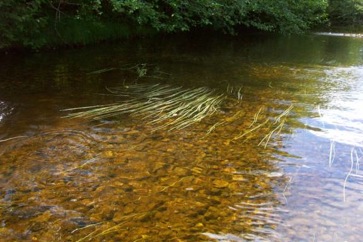
An occasional fry-sized fish was seen in the channel while walking the length. Several hundred fish (smolt sized, species unknown) were seen at the extreme top of leg 1, immediately below the water entry point. This entire leg is too deep to clean and would be left as it is. These resident fish would not be disturbed by the proposed cleaning operation.
Proposed Cleaning Procedure
As outlined earlier in previous correspondence, the proposed cleaning methodology will be followed with slight changes. A reiteration is in order.
Starting at the bottom of leg 1, an excavator, using a scoop and recast method will be employed. Should cleaning permission be given, the plan is to use a clean, new, midsize excavator to pick and redistribute the gravel using flows to move any particulates downstream and wash the gravel. This cleaning method is one of several but is the best one for this site. A recent cleaning at the Hill Creek Channel, a kokanee channel, employed this method which I recommended. The e/f survival went from 0 and 2 % to over 40 and over 50 % in the past two years. (C. Spence, pers. comm.)
Water flow would be around 40 cfs, below current background levels and pumps capable of pumping 60 cfs would be used to pump the effluent to two areas adjacent to the channel. Refer to the aerial photo and Fig. 1.
Figure 1:
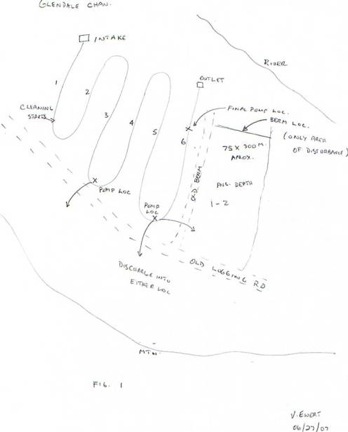
Initially, the first pump would be placed at the bottom of leg No.3 and discharge would be directed across an old logging road to a large wooded area that is completely enclosed by the old road on one side and a mountain on the other. Below leg No. 3, pumps would be relocated to the end of leg No. 6 and discharge could be pumped to two areas. Either the previously mentioned location or one that is of approximately 75m. by 300m. could be used. This second area borders the last leg, top to bottom and averages 1 to 2 meters in depth. A wide berm parallels this last leg and the only work required to completely contain this area is to create a small berm or dam across the bottom end. No effluent will be allowed to enter Glendale River.
Two floating containment booms spanning the channel width would be present in the event of equipment failure or refueling spillage .If required, vegetable oil could be used instead of conventional hydraulic oil.
While pumps are set up, etc., a crew of four men would start and stay in front of the excavator removing cobble from the gravel beds and repacking it against the berm banks. As well, the lowest branches that obstruct the vision and prevent proper cleaning under the overhanging vegetation would be removed using small chainsaws. A minimum of branches will be removed, only the bottom 1.5 meters, or so. The crew will be made available through Chief Fred Glendale from the Knight Inlet area.
A minimum of disturbance to the wooded areas will be done by the equipment. The dam in the second land containment area will be placed approximately 75 meters upstream of the channel outlet, well above the viewing area (H. Payne, pers. comm.) for those coming to see the grizzly bears.
It is anticipated that the entire period for cleaning is expected to take 10 days or less. Since this proposal is being given at a late date there is only a small timeframe remaining. It is hoped that permission could be given at the earliest date possible. In order to meet the concerns of numerous parties, all work should be done by the 17th of July at the latest. It is hoped that equipment, etc., could be barged in on July 5th with actual cleaning starting on the 7th.]
I would be present the entire period and would ensure that substrate material was not disturbed and that expressed concerns were met.
Recommendations
Aside from the rational for cleaning, which is covered in the following section, the most obvious recommendation is that a closer look at maintenance and operational procedures is in order. These would spell out parameters that are now absent or done a best guess basis.
There is one operational recommendation that needs to be addressed as soon as conditions permit (too late for this year), and that is that the valve at the top end of the channel regulating flows needs to be changed. This valve currently does not permit full utilization. The range of movement prevents a proper degree of flow control and is limited to the actual range of the recent flow regime. This valve is at the point of imminent failure. There is a risk, for example, of the valve being frozen in a position of low flow which would be inadequate for the adult spawners, resulting in low DO’s and mortality.
Summary & Concluding Remarks
In viewing a spawning channel, it helps to adopt a perspective that recognizes the uniqueness of this enhancement tool. This is not to say that channels are more complex or more difficult to manage than hatcheries. Rather, a recognition that the facility and its’ infrastructure is engineered and is more than a ditch filled with water and that it can not remain productive without a significant degree of maintenance and management.
It must be remembered that aside from the water quality, the gravel medium where all the development occurs is of critical importance. The gravel beds act as a giant incubator tray where anything that interferes with the successful deposition and development will produce stress, lessen survival and affect the fry quality. Simply put, cleaner, well mixed gravel results in better intra gravel flow, higher available oxygen thus increases a higher e/f survival.
In my opinion, the present conditions of the beds provides no greater e/f survival than found outside of the channel and may perhaps even be worse.
Based on my assessment of the current gravel bed conditions in the Glendale Channel, I highly recommend that a cleaning operation take place. It is recognized that a late date approval is not ideal, however, there currently exists an opportunity to have this done.
Victor Ewert
Redfish Services
June 28, 2007
June 13, 2007 - Glacier Falls restocking
Time, money and effort were spent and despite what appeared to be progress, at the last minute Marine Harvest alleged that their fish grew too slowly at their Humphrey Rock and Sargeaunt Pass fish farms and so they left their fish in the water through the wild salmon out-migration.
As expected the sea lice epidemic reappeared this spring around their salmon farms.
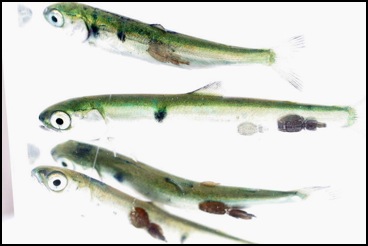
The Pacific Salmon Forum has now joined CAAR in
seeking cooperation from Marine Harvest and Cermaq
to fallow specific fish farms in 2008 so that, once
again, we can confirm or dismiss the relationship
between fish farms, sea lice and decline in BC wild
salmon. The Pacific Salmon Forum is funding
baseline work in anticipation of the 2008 fallow
and yet, yesterday I observed that one of the fish
farms on the proposed fallow route is preparing to
restock.
Glacier Falls, as this site is known, is a Marine
Harvest Canada (Pan Fish) owned site. It is
placed in an area crucial to wild juvenile salmon
in the Broughton Archipelago and specifically
Canada's 3rd largest pink salmon stock. Young
wild salmon amass at this location in the most
delicate stage of their lives while they are tiny
weighing less than 0.5 grams, because the contour
of the shoreline gives fish a place to feed and
rest.
If Marine Harvest continues to restock Glacier
Falls, they will once again prevent scientists from
studying the impact of farm fish. I would
like to know why the government funded Pacific
Salmon Forum is not aware that there will be no
fallow route in 2008. I would like to know
why a Norwegian company is allowed to defy all
attempts to do the science required to determine if
their fish farms are threatening one of the biggest
wild salmon populations in Canada?
I have to concur with Dr Larry Dill, Simon Fraser
University, who quit the Pacific Salmon Forum out
of frustration '"Really, the farms don't want us to
find an answer, let's be honest about that. The
answer is one they don't want to hear." Globe and
Mail June 11, 2007.
The Special Committee on Sustainable Aquaculture,
recommended moving farm fish into closed containers
to separate the farm and wild salmon to the benefit
of all. Seven days later the Minister in charge,
Pat Bell, signaled the industry not to worry it
will be business as usual by granting yet another
new open net pen farm.
Please contact me at this email address for tour of
the 2007 sea lice epidemic, leaving Port McNeill
Friday June 15.
Sea lice from salmon farms are killing wild salmon
in BC just as they have in Norway where Marine
Harvest and Cermaq call home. While these
corporations acknowledge sea lice are a problem and
act accordingly in Norway, they have a relationship
with Canada that allows destruction of wild salmon
that belong to the Canadian public and future
generations.
For visuals on the 2007 sea lice epidemics and
research please view videos at:
www.callingfromthecoast.com
Alexandra Morton
June 11, 2007 - Sea Lice Salmon researchers need . . .
The Globe and Mail
Monday 11 Jun 2007
Byline: Mark Hume
With files from Armina Ligaya in Mission
The fish-farming industry in British Columbia has long claimed it is on the side of science.
But when the provincially funded Pacific Salmon Forum set out to study the relationship of salmon farms to sea lice in the Broughton Archipelago, industry balked.
"Basically they refused to even come to the table and talk," said Larry Dill who, along with the two other members of the Forum's science advisory committee, Don McQueen and Michael Berry, recently resigned.
Dr. Dill said he quit out of frustration with the fish-farming industry and with the inability of the Pacific Salmon Foundation to get industry to co-operate.
The Pacific Salmon Forum, which was established by Premier Gordon Campbell in large part to bring the rationality of science to the emotionally charged fish-farm debate, is spending nearly $2-million on research projects in the Broughton Archipelago this year and next.
Dr. Dill and his two colleagues were co-ordinating the project, and their aim was to get independent researchers and Department of Fisheries and Oceans scientists - two groups that have often been at odds on the sea-lice issue - working together. Industry was expected to support the project by providing important information about their operations, and by agreeing to fallow some farms so scientists could do comparative studies.
"Much of this project required the assistance and co-operation of the industry," Dr. Dill said. "We needed to know from them how many fish were in their pens and how much lice they had and how much chemicals they'd been using to treat them.
We basically determined we weren't going to get co-operation from industry. They simply weren't interested . . . and for some reason . . . the Pacific Salmon Forum seemed either unwilling or unable to get them to the table.
"So it became apparent to the three of us . . . the hope of bringing this all together in a two-year period with an experimental fallowing period was just not going to happen. At the beginning of May the three of us all resigned . . . feeling that we just couldn't do any more without the co-operation of industry."
Dr. Dill said it's obvious to him that industry isn't participating because of fear the science will confirm that sea lice are multiplying in fish pens and spreading to wild stocks.
"Really, the farms don't want us to find an answer, let's be honest about that. The answer is one they don't want to hear," he said.
"As a scientist . . . I have absolutely no doubt that the farms are causing a problem. And I think all the scientific data that I've seen is virtually unanimous on that point."
John Fraser, director of the Pacific Salmon Forum, said that while Dr. Dill and Dr. McQueen did resign, Mr. Berry has remained involved (the Forum website says he is providing field co-ordination) and new members have been appointed to the science advisory committee, which remains in operation.
"We know there have been complaints," he said when asked about industry not being supportive.
"We've discussed this with industry. I think we're getting support from some people and that's all I'm prepared to say about that."
He said the resignations would not bring an end to the Pacific Salmon Forum's research.
But without crucial data provided by industry, that research will not be as definitive as it should be.
Mr. Fraser is too much of a diplomat to criticize the industry in public, but in private he and Premier Campbell should be making one thing very clear. If industry isn't going to be part of the solution, then it will have to be seen as the problem - and it should be regulated accordingly.
Mary Ellen Walling, executive director of the British Columbia Salmon Farmers Association, couldn't be reached for comment. But the industry website has this to say about the topic of sea lice: "As an industry we are committed to continuing to work with regulators, scientists and other interested parties to address this issue."
Fine words but they need to add a footnote: When it suits us.

